new posts in all blogs
Viewing: Blog Posts Tagged with: Wheels of Change, Most Recent at Top [Help]
Results 1 - 9 of 9
How to use this Page
You are viewing the most recent posts tagged with the words: Wheels of Change in the JacketFlap blog reader. What is a tag? Think of a tag as a keyword or category label. Tags can both help you find posts on JacketFlap.com as well as provide an easy way for you to "remember" and classify posts for later recall. Try adding a tag yourself by clicking "Add a tag" below a post's header. Scroll down through the list of Recent Posts in the left column and click on a post title that sounds interesting. You can view all posts from a specific blog by clicking the Blog name in the right column, or you can click a 'More Posts from this Blog' link in any individual post.
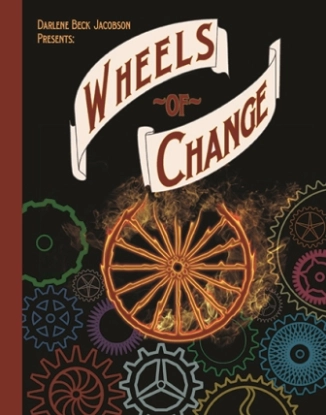 You know I love lists. I’m a listophile. This blog features t a list of 500+ Things that Kids Like, Things They DON’T Like, and a list of over 200 fun, cool and interesting words. List-o-mania! List-o-rama! The lister! (Pretend I’m talking in Rob Schneider’s SNL “annoying office guy” voice.)
You know I love lists. I’m a listophile. This blog features t a list of 500+ Things that Kids Like, Things They DON’T Like, and a list of over 200 fun, cool and interesting words. List-o-mania! List-o-rama! The lister! (Pretend I’m talking in Rob Schneider’s SNL “annoying office guy” voice.)
Today I invited debut author Darlene Beck Jacobson to the blog to share the Top 10 Toys and Candies of the early 1900’s, the time when times, well, they were a-changin’. It was also the time during her new middle grade novel, WHEELS OF CHANGE! (Don’t you just LOVE that cover?)
TOP TEN TOYS OF 1900-1920
- Teddy Bear (1902)—in honor of President Theodore Roosevelt who, on a hunting trip, had an opportunity to kill a bear and didn’t.
- Erector Set—invented by AC Gilbert, a gold medal Olympian in the 1908 Pole Vault.
- Lionel Trains (1901)
- Lincoln Logs (1916)
- Raggedy Ann Doll
- Radio Flyer Wagon (1917)
- Tinker Toys (1914)
- Crayola Crayons 8 pack (1903)
- Tin Toys
- Tiddlywinks
Other popular toys of the time included: Baseball Cards (1900), Ping Pong (1901), Jigsaw Puzzle (1909), Snap Card Game, playing cards, marbles, checkers, chess, yo-yos, wooden tops and (of course) dolls.
Let’s see, what would the top 10 toys of today be? I think Teddy Bears might still have a shot at it. Maybe Crayola crayons, too. But I bet no one back then could envision an app being the most popular toy. (An app? they might say. You mean a tiny apple?)
Now let’s devour the top tasty treats of the era!
POPULAR CANDY FROM 1900-1920
- Candy Corn (1880-s)
- Juicy Fruit Gum, Wrigley’s Spearmint Gum (1893)
- Tootsie Rolls (1896)
- Hershey’s Milk Chocolate Bar (1900) with Almonds (1908)
- Necco Wafers (1901)
- Conversation Hearts (1902)
- Brach Wrapped Caramels (1904)
- Hershey Milk Chocolate Kisses (1906)
- Peppermint Lifesavers (1912)
Hmm, I think Hershey would still rank pretty high today. But my kids love Sour Patch and Fun Dip and AirHeads and all kinds of gross things now. Give me a Hershey’s any day (although make it a Cookies-n-Cream bar).
Last night was back-to-school night at my daughter’s elementary, and I’m astounded every year when the principal says, “Our children will be working in fields that haven’t even been invented yet.” That’s how fast things are moving. I’m sure in another hundred years the top toys will be time machines and molecular transporters that will bring the catchphrase “Beam me up, Scotty” back in style.
Today’s world is moving fast, and that tempo is paralleled in WHEELS OF CHANGE with racial intolerance, social change and sweeping progress. It is a turbulent time growing up in 1908. For twelve year old EMILY SOPER, life in Papa’s carriage barn is magic. Emily is more at homehearing the symphony of the blacksmith’s hammer, than trying to conform to the proper expectations of females. Many prominent people own Papa’s carriages. He receives an order to make one for President Theodore Roosevelt. Papa’s livelihood becomes threatened by racist neighbors, and horsepower of a different sort. Emily is determined to save Papa’s business even if she has to go all the way to the President.
Sounds exciting, right? IT IS!
And guess what, you have yet another chance to win another book! Leave a comment stating what YOU think the #1 toy and #1 candy is right now, in 2014. You have until the last seconds of September 29th to enter. The winner receives WHEELS OF CHANGE.
To learn more about Darlene Beck Jacobsen and WHEELS OF CHANGE, visit DarleneBeckJacobson.com.
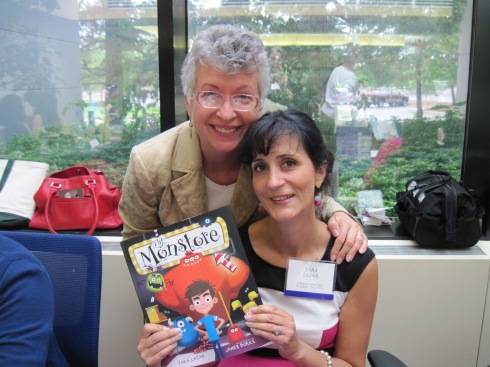
Tara and Darlene at NJ-SCBWI 2013!


 Darlene’s Debut Historical Novel WHEELS OF CHANGE launches on September 22nd. I am only too glad to be part of Darlene’s Blog Tour.
Darlene’s Debut Historical Novel WHEELS OF CHANGE launches on September 22nd. I am only too glad to be part of Darlene’s Blog Tour.
Darlene gave me an advanced copy and I loved the book. It is a middle grade book, so YA readers don’t expect to find steamy and edgy. What you do find is a well-written book that everyone will enjoy. I like that she based it on some real life events that happened in her Grandmother’s life.
We are very lucky. Darlene has agreed to give one lucky visitor a copy of her book. All you have to do is leave a comment below to have a chance to win. Want to up your chance? Then twitter about it, post on facebook, or another social media site, and let me know. I will add your name on a piece of paper for each thing you do. On September 18th, I will announce the winner and have Darlene mail out your copy. Please note: Darlene will pay for US shipping and any other reasonable shipping, but she may have to refuse shipping to every country around the world.
Three Fun Facts About Darlene:
- Even though I can’t swim, I snorkeled in the Great Barrier Reef in Australia thanks to a life jacket and swim ring. It was magnificent…and scary. Without the swim ring there was NOTHING to hold onto.
- I like trying new food and have enjoyed the following:
- Frog legs (tastes like chicken wings) and Escargo (garlicky and melts in the mouth) in Paris.
- Ostrich (like filet mignon) in Lambertville, NJ
- Crocodile (chewy and fishy, like clams) and Kangaroo (like ground beef only better) Both in Australia
- Buffalo (leaner and more tender than beef) in Western Canada
- Passion Fruit (sweet and delicious) in Hawaii
- Conch (heavenly) Florida keys
- Panga Fish (BEST fish I’ve ever eaten, bar none) in Vollendam, Netherlands
Food you couldn’t pay me to eat again: Poi (wallpaper paste tastes better) and Vegemite (way too salty)
- I love learning new things and have taken classes in:
- Flint napping
- Navaho rug weaving
- Origami
- Crazy quilting
- Pisanki (Polish egg decorating)
Three Fun Facts About Darlene’s Grandmother – the real Emily Soper:
- She was a debutante in Washington DC Society and travelled in the same social circles as Alice Roosevelt.
- She lost her standing in society when she married my grandfather for love instead marrying for money and status.
- She was 4 feet 11 inches tall.
Filed under:
Author,
Book Tour Tagged:
Blog Tour,
book give-a-way,
Darlene Beck-Jacobson,
Wheels of Change 

After running errands this morning, I came back home to find the mail truck parked at the curb. I got out of the car and greeted my mail woman Dawn. “I have something for you,” she said.
As soon as I saw the box…I knew…they had finally arrived….
My box of…. 
BOOKS! MY BOOKS…The one I wrote and was lucky enough to have published!
You should know that I have the best mail person in the Universe! What a way to start a day!



By: Kathy Temean,
on 5/31/2014
Blog:
Writing and Illustrating
(
Login to Add to MyJacketFlap)
JacketFlap tags:
inspiration,
Process,
How to,
Study Guide,
demystify,
Wheels of Change,
Darlene Beck-Jacobson,
Study Guide Example,
marketing,
Writing Tips,
Add a tag
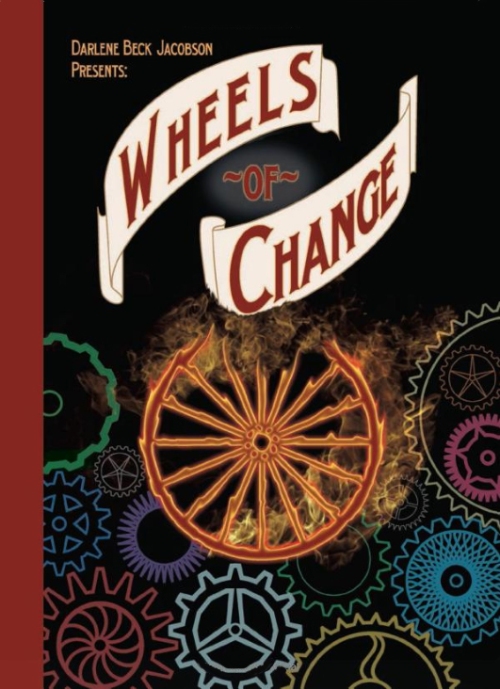
WHEELS OF CHANGE STUDY GUIDE
- Change is the overriding theme of this novel. Discuss good vs. bad change and how the characters accepted or rejected change. CCSS RL 4.9
- How did Emily’s ideas about change evolve throughout the story? CCSS RL 3.3
- What does the horseshoe symbolize? Do you think it really had power? Explain. CCSS RL 5.4
- Do you think Beatrice’s personality and behavior are her own or as result of trying to please her mother? CCSS RL 3.3
- What characteristics made Charlie a good friend for Emily? Vice versa. CCSS RL 3.3
- What do you think of Emily’s reaction to Mrs. Peabody’s comments at the tea? Was Emily justified in dumping tea in Mrs. Peabody’s lap? Explain why or why not. What would you have done? CCSS RL 4.3
- 1908-09 was a time in history when segregation was common. Do you think Mr. Soper was courageous in employing an African-American? Explain. CCSS RL 3.3
- Was life easier or harder in 1909? What did you like about the time period?
- The roles of males and females were more sharply divided in the early 20th Century. Do you think Emily’s resistance to learning proper lady-like behavior was typical for girls her age? Why or why not? CCSS RL 4.3
- How did Emily’s relationship with Mama change? CCSS RL 5.2
- The story takes place when there were fewer luxuries in everyday life – especially regarding entertainment. What would you do if you had no radio, television, telephone, electricity or car, like most of the people in the story? CCSS RL 4.9
- Learning skills and being self-sufficient was important during this time in history. Why? Do you think these values are still important today? Explain.
- Emily and Charlie were expected to help the family by doing daily chores. If they weren’t completed, the household and family suffered. Does your family depend on you to do certain jobs? What would happen if you didn’t do them? CCSS RL 4.9
- What did Emily expect President Roosevelt to do for Papa? CCSS RL 4.3
- What did you think of Emily’s suggestions for changing Papa’s business? What might you have done to help? CCSS RL 4.9
- Do you think it was foolish or brave of Emily to stay in the barn during the fire? What would you have done? CCSS RL 3.3
- There were limited opportunities for women at the turn of the 20th Century. Single women who were not from wealthy families could teach, work long hours in a factory under awful conditions, or work as maids, governesses, or servants to wealthy families. Once married, they were expected to stay home and care for their husband and children. Do the opportunities enjoyed by women today make their lives easier or more difficult? Explain. CCSS RL 4.9
- When Mama first meets Mrs. Jackson, they seem ill as ease with one another. Why? CCSS RL 5.2
- Do you think it was unusual for Emily’s best friend to be a boy? Why or why not?
- If the story took place today, do you think it would be easy for a girl to become a blacksmith? Explain.
Hope this gives you some ideas of how proceed when you publish your book.
Talk tomorrow,
Kathy
Filed under:
demystify,
How to,
inspiration,
marketing,
Process,
Writing Tips Tagged:
Darlene Beck-Jacobson,
Study Guide,
Study Guide Example,
Wheels of Change 


By: Kathy Temean,
on 5/27/2014
Blog:
Writing and Illustrating
(
Login to Add to MyJacketFlap)
JacketFlap tags:
Marketing a book,
Wheels of Change,
Darlene Beck-Jacobson,
Curriculum Guide Example,
Secon Industrial Revolution,
Women gaining independence,
reference,
inspiration,
Process,
Add a tag
WHEELS OF CHANGE CURRICULUM GUIDE
Introduce students to the Industrial Revolution at the turn of the Twentieth Century, using the book as a basis for discussions. This topic is part of the national learning standards and curriculum for U.S. History.
Topics for discussion:
- Introduce causes of the Industrial Revolution and how it changed the workplace and production of goods in America.
- Discuss handmade vs. factory made goods.
- Discuss good change vs. bad change and how it affects individuals and society.
- Discuss women’s emerging independence, their role in the workplace and at home, and how this affects the family.
Objectives:
- To understand the causes and effects of the Second Industrial Revolution (1890’s through WWI)
- To understand how progress has negative as well as positive consequences for individuals and society.
- To understand how even when some members of society benefit from changes, others may not.
- To witness a personal perspective to a period in our nation’s history.
Key Words/Concepts:
- Mass Production
- Assembly lines
- Women’s Suffrage
- Segregation/Prejudice
- Mechanization
Background:
The Industrial Revolution began in the late 1700’s through the 1840’s when goods formerly produced by hand began to be made with machines. Almost every aspect of daily life was influenced in some way. The second wave of industrialization occurred at the turn of the Twentieth Century and lasted until World War I. This revolution revolved around steel, railroad expansion, electricity, chemicals, and communication.
Mass production of steel replaced hand wrought iron. Blacksmiths – like Henry Johnson in WHEELS OF CHANGE – would no longer be needed to produce the rails, machine components and tools used to manufacture goods and move them from one place to another. Railroads replaced steamboats to transport goods over longer lasting steel rails. Electricity allowed factories to increase production of clothing and household goods. It also made it possible for Henry Ford to redesign the factory using tools and specialized machines positioned in a unique sequence to eliminate unnecessary human movement. The assembly line was born. More goods made in less time at a cheaper cost.
It took Mr. Soper weeks to make one of his carriages. It also took Henry days to hammer out all the iron needed to support the carriage body. The new factory system eliminated this labor-intensive process.
Part One: Making the topic relevant:
Begin a discussion on all the modern conveniences we all enjoy thanks to factory made products. When things get lost or broken we can easily and cheaply replace them.
Part Two: Read WHEELS OF CHANGE with students and start a discussion using the following topics:
- Why was Emily worried about automobiles coming to town? Was her worry real or imagined?
- How did having electricity and a telephone change life for Emily and her family?
- Emily’s mama had few modern appliances or household gadgets. How would having these things change her life?
- Why were some people upset when papa employed an African American blacksmith? How did prejudice impact some of the decisions actions taken in the story?
- Women could not vote and had few rights in 1908. Why do you think so many people were opposed to allowing women the right to vote?
- Why was the telegraph and mail service so important in the early 1900’s?
Concluding Activity: Have students write about what their lives would be like without electricity, telephones, or motor cars. Would some aspects of life be better without those things?
Or, have them write about prejudice and being judged by the color of your skin. Should groups be singled out based on ethnic origin, religion, or political beliefs? Where in the world are these things still taking place today?
Stop back on Sunday to view Darlene’s Study Guide.
Talk tomorrow,
Kathy
Further Study:
http://en.wikipedia.org/wiki/Second_Industrial_Revolution
www.ushistoryscene.com/uncategorized/secondindustrialrevolution/
Filed under:
inspiration,
Marketing a book,
Process,
reference Tagged:
Curriculum Guide Example,
Darlene Beck-Jacobson,
Secon Industrial Revolution,
Wheels of Change,
Women gaining independence 


By: Kathy Temean,
on 5/27/2014
Blog:
Writing and Illustrating
(
Login to Add to MyJacketFlap)
JacketFlap tags:
Wheels of Change,
Darlene Beck-Jacobson,
Curriculum Guide Example,
Secon Industrial Revolution,
Women gaining independence,
reference,
inspiration,
Process,
Marketing a book,
Add a tag
WHEELS OF CHANGE CURRICULUM GUIDE
Introduce students to the Industrial Revolution at the turn of the Twentieth Century, using the book as a basis for discussions. This topic is part of the national learning standards and curriculum for U.S. History.
Topics for discussion:
- Introduce causes of the Industrial Revolution and how it changed the workplace and production of goods in America.
- Discuss handmade vs. factory made goods.
- Discuss good change vs. bad change and how it affects individuals and society.
- Discuss women’s emerging independence, their role in the workplace and at home, and how this affects the family.
Objectives:
- To understand the causes and effects of the Second Industrial Revolution (1890’s through WWI)
- To understand how progress has negative as well as positive consequences for individuals and society.
- To understand how even when some members of society benefit from changes, others may not.
- To witness a personal perspective to a period in our nation’s history.
Key Words/Concepts:
- Mass Production
- Assembly lines
- Women’s Suffrage
- Segregation/Prejudice
- Mechanization
Background:
The Industrial Revolution began in the late 1700’s through the 1840’s when goods formerly produced by hand began to be made with machines. Almost every aspect of daily life was influenced in some way. The second wave of industrialization occurred at the turn of the Twentieth Century and lasted until World War I. This revolution revolved around steel, railroad expansion, electricity, chemicals, and communication.
Mass production of steel replaced hand wrought iron. Blacksmiths – like Henry Johnson in WHEELS OF CHANGE – would no longer be needed to produce the rails, machine components and tools used to manufacture goods and move them from one place to another. Railroads replaced steamboats to transport goods over longer lasting steel rails. Electricity allowed factories to increase production of clothing and household goods. It also made it possible for Henry Ford to redesign the factory using tools and specialized machines positioned in a unique sequence to eliminate unnecessary human movement. The assembly line was born. More goods made in less time at a cheaper cost.
It took Mr. Soper weeks to make one of his carriages. It also took Henry days to hammer out all the iron needed to support the carriage body. The new factory system eliminated this labor-intensive process.
Part One: Making the topic relevant:
Begin a discussion on all the modern conveniences we all enjoy thanks to factory made products. When things get lost or broken we can easily and cheaply replace them.
Part Two: Read WHEELS OF CHANGE with students and start a discussion using the following topics:
- Why was Emily worried about automobiles coming to town? Was her worry real or imagined?
- How did having electricity and a telephone change life for Emily and her family?
- Emily’s mama had few modern appliances or household gadgets. How would having these things change her life?
- Why were some people upset when papa employed an African American blacksmith? How did prejudice impact some of the decisions actions taken in the story?
- Women could not vote and had few rights in 1908. Why do you think so many people were opposed to allowing women the right to vote?
- Why was the telegraph and mail service so important in the early 1900’s?
Concluding Activity: Have students write about what their lives would be like without electricity, telephones, or motor cars. Would some aspects of life be better without those things?
Or, have them write about prejudice and being judged by the color of your skin. Should groups be singled out based on ethnic origin, religion, or political beliefs? Where in the world are these things still taking place today?
Stop back on Sunday to view Darlene’s Study Guide.
Talk tomorrow,
Kathy
Further Study:
http://en.wikipedia.org/wiki/Second_Industrial_Revolution
www.ushistoryscene.com/uncategorized/secondindustrialrevolution/
Filed under:
inspiration,
Marketing a book,
Process,
reference Tagged:
Curriculum Guide Example,
Darlene Beck-Jacobson,
Secon Industrial Revolution,
Wheels of Change,
Women gaining independence 

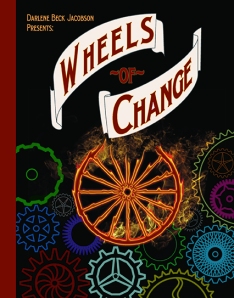 A few weeks ago I was out with Darlene Beck Jacobson and she started talking about the work she was doing to develop a curriculum and study guide for her debut book that is coming out in September.
A few weeks ago I was out with Darlene Beck Jacobson and she started talking about the work she was doing to develop a curriculum and study guide for her debut book that is coming out in September.
I asked her to share what she was doing with all of you, since we can all learn from each other. Here is part one of the three part series.
TYING YOUR NOVEL INTO THE CORE CURRICULUM By Darlene Beck Jacobson
Schools are changing. So are the curriculum requirements. With teachers being squeezed for time and tight budgets limiting purchases of “frivolous” things like fiction for the classroom, what can we writers do to give our books a fighting chance on classroom reading lists?
You can develop a CURRICULM GUIDE and STUDY QUESTIONS to tie into the Core Curriculum Content Standards. For my historical middle grade novel WHEELS OF CHANGE, which takes place in 1908 Washington DC, I developed a curriculum guide on the second wave of the Industrial Revolution. (see attached)
I also did a separate set of Study Questions that tie into Reading and Literature objectives. (see attached) You can do the same thing for your novel…even if it isn’t historical. Begin by generating questions that fit the Reading and Literature sections of the standards. Then look for the universal theme or ideas that would generate good classroom discussions on topics that cover important issues such as war, homelessness, divorce, illness, poverty, prejudice, etc. These topics can be part of Science, Health, and Social Studies units. Fellow writers have even tied their books into art and music areas as well.
You can also develop worksheets, puzzles, games or other reproducible activity sheets that teachers can use in the classroom. Everything you can do to make life easier for a teacher, will help make your book stand out from all the others that cry for attention in the curriculum.
To learn more about Common Core Standards visit: www.commoncorestandards.org
PART II: Curriculum Guide tomorrow
Darlene Beck Jacobson has loved writing since she was a girl. She also loves bringing the past to life in stories such as WHEELS OF CHANGE (Creston Books), her debut novel. Her stories have appeared in CICADA, CRICKET, and other magazines. Her blog features recipes, activities, crafts and interviews with children’s book authors and illustrators. She still loves writing and getting letters. Check out her website at: http://www.darlenebeckjacobson.com
WHEELS OF CHANGE is due out on September 22, 2014.
Talk tomorrow,
Kathy
Filed under:
article,
How to,
reference Tagged:
Common core Guidelines,
Curriculum Guide,
Darlene Beck-Jacobson,
Study Guide,
Wheels of Change 

Girls will feel like they've strapped on wings after reading these captivating true stories of early 20th Century women who refused to let their future be decided for them.
Just in time for Women's History Month come two stellar accounts of women who challenged themselves to dream bigger than women ever had: Wheels of Change by Sue Macy and Amelia Lost by Candace Fleming.
Each book is meticulously researched, and packed with gems of information -- anecdotes, quotations, even poems -- that will make readers' spirits soar and inspire girls to be confident in their pursuits and not let anyone hold them back.
How Women Rode the Bicycle to Freedom (With a Few Flat Tires Along the Way)
By Sue Macy
$18.95, ages 8 and up, 96 pages
At the close of the 19th Century, the bicycle was like a silent steed for women -- helping them break free of society's rigid hold and carve their own dreams, according to this charming account.
"Imagine a population imprisoned by their very clothing: the stiff corsets, heavy skirts...," award-winning Macy writes. "...And how liberated they must have been as they pedaled their wheels toward new horizons."
With the arrival of the high-wheeler and later bicycles in America, women gained a degree of mobility they'd never known, and as such, they were gradually, often unconsciously led to try things that at the time only men were allowed to do.
The female cyclist "did not have to be born again in some mysterious fashion, becoming a strange creature, a 'new woman,'" Munsey's Magazine suggested in 1896. "She is more like the 'eternal feminine,' who has taken on wings, and who is using them with an ever increasing delight in her new power."
A few years later, a French cycling poster echoed this perception, showing a Athenian-looking woman with angel wings standing beside her two-wheeler.
The bicycle spurred a fundamental shift in how women were looked upon. Until then, women felt restricted to home and were strictly supervised; now they could hop on a bike and go for a ride and get exercise.
The advent of the two-wheeler "has done more to emancipate women than anything else in the world," wrote civil rights activist Susan B. Anthony in 1896. "I stand and rejoice every time I see a woman ride by on a wheel."
As more women took to pedals, "rational" fashion had to go, and along with it, straight-laced ideas of propriety.
Full skirts, corsets and bulky petticoats of the day were impractical, even dangerous. Fabric would catch in crank bracket and send women flying. So a less restrictive style of dress was born, beginning with ungainly bloomers and eventually shifting to shorter skirts.
Soon women felt encouraged to enter bicycle races and were joining other feminists in demanding the right for better schooling and jobs. However, the road to equality was bumpy, much like the dirt roads they rod
 You know I love lists. I’m a listophile. This blog features t a list of 500+ Things that Kids Like, Things They DON’T Like, and a list of over 200 fun, cool and interesting words. List-o-mania! List-o-rama! The lister! (Pretend I’m talking in Rob Schneider’s SNL “annoying office guy” voice.)
You know I love lists. I’m a listophile. This blog features t a list of 500+ Things that Kids Like, Things They DON’T Like, and a list of over 200 fun, cool and interesting words. List-o-mania! List-o-rama! The lister! (Pretend I’m talking in Rob Schneider’s SNL “annoying office guy” voice.)



 Darlene’s Debut Historical Novel WHEELS OF CHANGE launches on September 22nd. I am only too glad to be part of Darlene’s Blog Tour.
Darlene’s Debut Historical Novel WHEELS OF CHANGE launches on September 22nd. I am only too glad to be part of Darlene’s Blog Tour. 

 A few weeks ago I was out with Darlene Beck Jacobson and she started talking about the work she was doing to develop a curriculum and study guide for her debut book that is coming out in September.
A few weeks ago I was out with Darlene Beck Jacobson and she started talking about the work she was doing to develop a curriculum and study guide for her debut book that is coming out in September.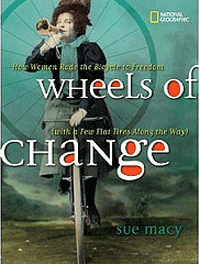
I work at a center for kids 1-7, and I’d say it’s a tie between bubbles, balls and toy cars for the little guys, action figures and Legos for the bigger guys. Another big favorite with the little ones is an empty coffee can with an x cut in the plastic lid and some wooden clothes pegs that they push down into the can! The older ones also love homemade playdough, and both ages like books.
Hmm . . . my guesses are PlayStation and Snickers.
Number 1 toy for boys is probably blocks/Legos and for girls, maybe American Girl dolls. If it had been last year, I would have said Rainbow Loom bracelets for both boys and girls but that ship seemed to set sail pretty quickly. For candy, gummies, Sour Patch, Nerds. Fun post!
Lego for toys and Swedish Fish for candy. Those are my favorites. My boys would ditto the Lego pick but probably opt for either Jolly Ranchers or Mike and Ike’s
Hmm Does Xbox count as a toy? And Monster High dolls. Great post! I can’t wait to read it! As for Candy the juicy drop pop.
Thanks for doing such an awesome job on the post Tara! I find it amazing that all the toys listed are still AVAILABLE in stores! And “old-timey” candies are popular again, thanks to baby-boomers wanting a taste of childhood. Anyone remember Chunky chocolate bars? A whole lot of chocolate for a nickle!
Thanks for the post and giveaway! I think Playstation and skittles are very popular today.
Fun lists! My guesses #1 toy – Legos & #1 candy – Snickers
I see a lot of my favourites in these 2 lists – like Tinkertoys and Lincoln Logs, which I could never get enough of as a child! As for the #1 toy and candy, I’d guess toy cars as top toy(s) and Reese’s Peanut Butter Cups as the top candy.
Hmmm, Sour patch kids and legos.
I love lists too! For 2014, going to go with Legos as the number one toy and for candy…hmmm, that’s a tough one. I am going with M&Ms even if that is not my favorite. My favorite is Twix. And Wheels of Change sounds like a great read.
I don’t have a guess. I can’t get past Necco Wafers #5. Seriously? Have they tasted Neccos? :)